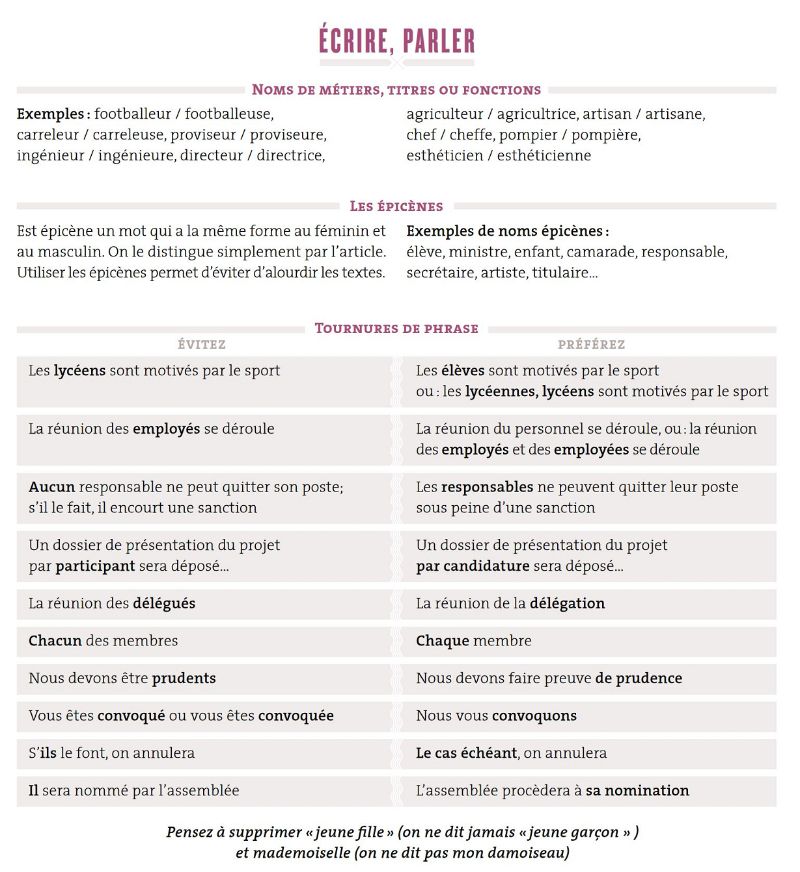
Several resources are available in this section to measure gender inequalities in universities (parity indicators, implicit association tests, etc.) and to fight against discrimination through good practices (e.g. guide to writing letters of recommendation, guide to recruiting without discrimination, etc.)
Communication guides without gender stereotypes |
||||||||||||||||||||||||||
|---|---|---|---|---|---|---|---|---|---|---|---|---|---|---|---|---|---|---|---|---|---|---|---|---|---|---|
|
The Ministry of Higher Education, Research and Innovation proposes a guide of good practices for gender equality on social networks and in communication. This guide is composed of 4 parts:
"Writing in a neutral manner reflects the desire to accompany a social evolution, marked by women's access to jobs, responsibilities, hierarchical positions, and an egalitarian existence. It is essential to integrate this dimension into the productions" - MESRI.
|
||||||||||||||||||||||||||
Parity indicators at the University |
||||||||||||||||||||||||||
|
Parity in universities can be measured through different indicators. In the document below we present different indicators with a focus on theAdverse Impact (also called Gender Advantage Index): how to calculate these indicators, on which data to apply them and how to interpret them. |
||||||||||||||||||||||||||
The Implicit Associations Test (IAT) |
||||||||||||||||||||||||||
|
As explained by Anthony G. Greenwald: "Psychologists suggest that people do not always express the substance of their thoughts either because they do not want to or because they are unable to do so [...] Implicit Association Tests (IATs) measure implicit attitudes or beliefs that people either do not want to express or are unable to report. The IAT is a quick, simple, and fun computerized test that can be used as a teaching tool to learn about the strength of certain associations of ideas in our memory, such as the associations between Science and Masculine and Letters and Feminine. The Implicit Associations Test (IAT) is a computerized word categorization task that was created in 1998 by Greenwald, McGhee, Schwartz. It is part of the theoretical field of social cognition, which studies how the context, in the broadest sense of the term, can influence cognitive functioning. The IAT is based on the functioning of information processing and in particular of semantic memory which organizes information into associative networks. Some information is strongly associated with each other (due to its simultaneous and repeated occurrence or use in daily life), others less so, and others not at all. When the association between two pieces of information is strong, it creates a kind of automatism that can be measured, in particular with response time tasks such as the IAT: as soon as a piece of information is retrieved from memory, the one associated with it is also retrieved, and this is done all the more rapidly as the association is strong. In spite of its apparent simplicity, the IAT allows us, if we take it seriously, to estimate the strength of associations between information in semantic memory. Several implicit association tests are available on Anthony G. Greenwald's site. Take them! link. Greenwald AG, McGhee DE, Schwartz JL. Measuring individual differences in implicit cognition: the implicit association test. J Pers Soc Psychol. 1998 Jun;74(6):1464-80. doi: 10.1037//0022-3514.74.6.1464. PMID: 9654756. |
||||||||||||||||||||||||||
Writing a Letter of Recommendation Free of Gender Stereotypes |
||||||||||||||||||||||||||
|
The Commission on the Status of Women at the University of Arizona offers (among other things) a list of words to avoid and use to write letters of recommendation without stereotypes. Indeed, compared to recommendation letters written for women, those written for men are 4 times more likely to mention publications and twice as likely to have multiple references to research. Conversely, letters of recommendation written for women are 7 times more likely to mention personal life, or other items unrelated to the application. We have translated this list of words to avoid and to focus on in order to write letters of recommendation without stereotypes.
|
||||||||||||||||||||||||||
Calculate the proportion of citations of women and men in your scientific papers |
||||||||||||||||||||||||||
|
What is the proportion of women and men you cite in your articles? In your thesis or in your HDR? Women are often cited less than men, yet even well-meaning academics can have trouble assessing the gender balance in their bibliographies. Counting is tedious, subject to human error, and academics may not know the gender of all the authors they cite. This tool aims to remedy this, by automating the process of assessing the gender of each name, and then providing an estimate of the percentage of women authors in a bibliography. The tool takes as input .txt or .bib files Recruiting without discriminationPractical guide to recruiting, welcoming and integrating without discrimination: this document, provided for in the national action plan for professional equality 2021-2023 common to the MENJS and the MESRI, is intended for all professionals in charge of recruitment and provides them with tools to carry out a process that guarantees equal treatment of all candidates. It is also of interest to all employees, who will find a reminder of the legal provisions on non-discrimination and the good practices that should follow. This guide, which was developed in consultation with staff representatives, illustrates the commitment of the two ministries to equality, diversity and the prevention of discrimination. |


